Of all the subgenres of horror, religious horror tends to be my favorite. When it’s good, you get all-time classics like Rosemary’s Baby, Hereditary, and The Exorcist. When it’s over-the-top, you get operatic shit like The Omen, Hellraiser, or, for my money, Constantine. And when it commits to being goofy as hell, you get… The Conjuring series. Even the bad examples of the genre will provide decent exorcism scenes or fun Satanic cults. And religious horror has inspired fantastic comedy like Good Omens, SNL’s Exorcist II, and some of the funniest scenes in This is the End.
This essay is going to dive into Midnight Mass’ place in the tradition of religious horror, and the Catholic iconography used—and it’s going to spoil everything, so if you want a light spoiler review you can head over here, but otherwise this essay assumes you’ve watched the whole show.
In most of these movies, religion is used in one of two ways: Catholicism is a creepy backdrop that is only vaguely understood by the protagonists, and adds to the horror; Catholicism is a series of rituals that are used to ward off the horror element—spiritual caulk plugging a crack in a wall. (And yes, it’s almost always Catholicism. I think Catholicism is just more visual. Where Protestantism lends itself to stark meditations on faith and doubt like First Reformed and most of Ingmar Bergman’s oeuvre, Catholicism is colorful and ancient. Exorcisms just sound better in Latin.)
Rosemary is a lapsed Catholic who doesn’t think about religion much, and thus is vulnerable to the Devil and her shitty, shitty husband. Chris MacNeil is actively atheist, and thus can’t protect her daughter Regan from Captain Howdy. The elite family of The Omen are Catholic, but don’t seem to practice… until it’s too late. (muahahaha.) Ed and Lorraine Warren use rosaries like dowsing rods to locate demonic entities, then yell rote prayers at increasing volume until the demons get fed up and leave… FOR NOW. (muahahaha.)
But, until recently, you didn’t get conversations about what demons are, what evil is, what it would mean to live in a universe where this stuff was all real. (Plenty of people live in a universe where this stuff is all real, and plenty of people don’t, and it’s the same universe, and the cultural ramifications of this fact will never stop being interesting to me.) Suddenly, I live in a universe where I can rewatch the two perfect seasons of The Exorcist TV spinoff. I can watchEvil. And now, I can watch Midnight Mass.
Though the odds of me rewatching it are low, for reasons I’ll get to in a sec.
Midnight Mass, more than any of the others, is RELIGIOUS horror. It is horror about religion. And it is so fucking good. Now obviously this is a sensitive topic, and if you’ve looked at Twitter over the weekend you may have noticed a lot of Catholic angst. Because I think this show is Catholic in a way that most religious horror isn’t—and maybe more importantly it’s ex-Catholic in a way that most things aren’t. It uses the usual imagery in ways that are full of love and nostalgia, but the show leaves room for real, raw anger. It deals honestly with how it feels to lose your faith and have to keep living without it. It deals honestly with how it feels to have faith in a world that’s pretty secular, and how it feels to have your faith attacked by those who don’t understand it. If there’s a faith base to cover, MM covers it. It doesn’t shy away from people using faith as a weapon, or a tool to manipulate the fearful. And best/worst of all, it deals with how those faiths affect people’s attitudes toward death.
There are three long “What happens when we die?” monologues in this show. They are each gutting in their own way, and they kept me up after I finished the last episode. The show makes room for a number of different interpretations of what death is, without ever tipping its hand toward or against anyone’s personal truth. And it’s these scenes that are the heart of the show, because Flanagan is good at horror, and understands that much of the genre is just people trying to deal with their knowledge of death. Vampires, ghosts, zombies—they’re all creatures who found a loophole, right? So how does it affect a community when the majority subscribe to a religion that promises them a nebulous, spiritual escape from death, but then they’re offered that escape in a new, tangible way?
This show is infused with death:
- This whole mess started because Monsignor John Pruitt couldn’t fully accept that his life was at an end, and allowed the vampire to give him a form of eternal life;
- Riley is walking dead—he can’t kill himself, but wishes he was the one who died in the accident;
- Erin Greene is harboring new life, and using that new life as the fulcrum for her own new life… and then that new life is taken away;
- Dr. Gunning is waiting to start her life until her mother dies;
- Sheriff Hassan and Ali are living in the shadow of Ali’s mom’s death, Hassan is holding the knowledge of that death in himself to spare Ali, but Ali sleeps next to a photograph of his mom and kisses it goodnight every night after prayers;
- The island itself is dead, as the fishing industry is on its last, er, fins;
- Leeza lives with phantom limbs, and the ghost of the life she would have had if Joe Collie hadn’t shot her;
- Joe Collie lives a shadow life of drunkenness and regret;
- Joe’s dog Pike dies;
- Like, all the cats die
- Bev Keane is revealed to be terrified of death by the end, as she desperately tries to dig a hole and hide from the sunrise. (Somebody skipped half the Psalms and all of Isaiah, apparently.)
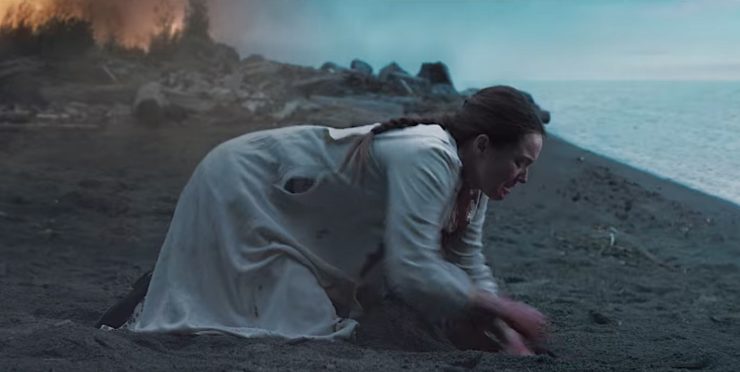
I know there’s more death? (Let me know in the comments!) But this is why I probably won’t rewatch this one. I love how fearless the show was in looking at this stuff, but it didn’t make for fun viewing for me, at least not after this fucking year.
One thing I didn’t get around to in my first review was the fact that after we see Riley’s room—the awesome shrine to late-90s excellence that includes a Se7en post, a Scream poster, AND the Scully-centric X-Files poster—when we finally get the pay-off about his nightmares, it’s literally an homage to “One Breath.”
“One Breath” was one of the standout episodes of The X-Files. (If you’re planning a first viewing of the show, skip this paragraph so you can see it for yourself without spoilers—it’s VERY good.) Scully has been kidnapped by Duane Barry and/or aliens, was missing for a while, and has now mysteriously turned up in a hospital. She hovers between life and death as Mulder searches desperately for her. The way Chris Carter and his team visualize “hovering between life and death” is that she’s sitting in a simple rowboat on a placid grey lake. In the show’s universe this is her soul, tethered to life but drifting away from it. She sees her dead dad, she sees her mom, sister, and Mulder, and Nurse Owens, who’s caring for her. It’s rather heavily implied that the nurse is an angel, ’cause again, late ‘90s. The plot culminates in her decision to stay, but the emotional climax of the episode comes when Mulder returns her crucifix, and Scully is confirmed in the show’s world as Conflicted Catholic Who Can Do God, But Not Aliens.
Which, given MM’s tortured relationship with Catholicism, I thought it was a pretty nice touch—when Riley’s recurring dream turns out to be him sitting in a rowboat on placid, grey water, waiting for sunrise. And obviously the pay-off, when this turns out to be something of a prophecy of his death, is fucking stunning. (It’s also kind of a sideways Buffy tribute? Since Angel tried to commit Sun Suicide once, until Miraculous Christmas Snow saved him.) Riley isn’t saved in that way of course—he burns up like neglected toast—but he is “saved” when the girl he killed appears before him in the boat, whole and unbroken, and lifts him up out of his seat. But again, Mike Flanagan’s gonna Mike Flanagan, and this beautiful scene of redemption cuts back to Riley’s body burning up as Erin Greene screams in horror at the other end of the rowboat. And both views of Riley’s death are correct.
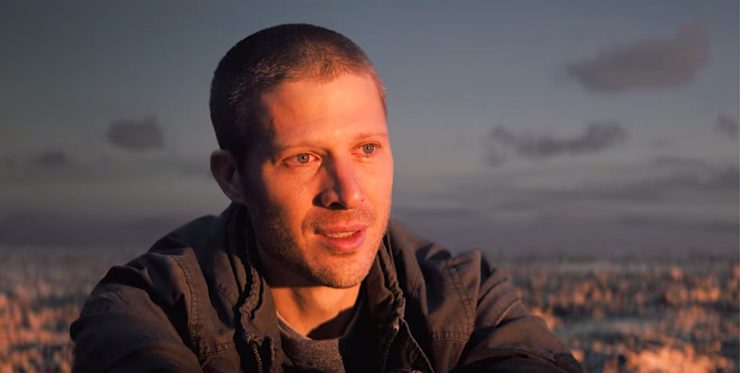
Since Mike Flanagan is a true Stephen King enthusiast, he’s poking at some of the same rotting logs that King does. One of those, and one of the most fascinating aspects of the show, is its interrogation of the nature of miracles. In IT, Stephen King gives Stan Uris a long interior monologue about the line between miracles and horror. I won’t quote the whole thing, but the idea is that since miracles are super-natural, they’re as offensive to the idea of an orderly universe as, say, the horrors Pennywise creates to terrorize Derry, Maine. Stan, the only Jewish kid in town, makes the very easy mental jump from Pennywise to the kinds of stories his Christian friends accept without question:
“You can live with fear, I think,” Stan would have said if he could. “Maybe not forever, but for a long, long time. It’s offense you maybe can’t live with, because it opens up a crack inside your thinking, and if you look down into it you see there are live things down there, and they have little yellow eyes that don’t blink, and there’s a stink down in that dark, and after a while you think maybe there’s a whole other universe down there, a universe where a square moon rises in the sky, and the stars laugh in cold voices, and some of the triangles have four sides, and some have five, and some of them have five raised to the fifth power of sides. In this universe there might grow roses which sing. Everything leads to everything…Go to your church and listen to your stories about Jesus walking on the water, but if I saw a guy doing that I’d scream and scream and scream. Because it wouldn’t look like a miracle to me. It would look like an offense.”
Here on Crockett Island (the Crock-Pot!), regular folks are shown a classic miracle. A young girl in a wheelchair is able to rise and walk. The girl is only in the wheelchair because the town drunk shot her through the spine—a terrible accident! A traumatic break in the town routine. Her sudden ability to walk again can be seen as a return to normal, the path her life was supposed to take before Joe Collie pulled that trigger. Since this happens in church, at the behest of their charismatic new priest, these good people who have all felt sorry for the girl are more than willing to believe that God has reached down into their town. When Leeza’s recovery inspires Joe Collie to give up drinking? Another miracle! When the older folks notice that their wrinkles are smoothing, their backs don’t ache so much, they can dance with their wives again? Well! Clearly, it is a time of miracles, because these are things they want. They don’t realize that one of the miracles is that Erin Greene’s baby disappears from her womb. Or muse on the implication that, if Mildred Gunning is suddenly young again, that might mean her daughter can’t start a new life on the mainland with her girlfriend. Or that these miracles seem to only happen to those currently in a state of Grace according to St. Patrick’s Church (est. 1824), thus leaving Sheriff Hassan, his son Ali, Dr. Gunning, and Riley Flynn out in the cold, miraculously speaking. They don’t dwell on how this allows Bible Study to creep into their state-funded, secular schoolroom.
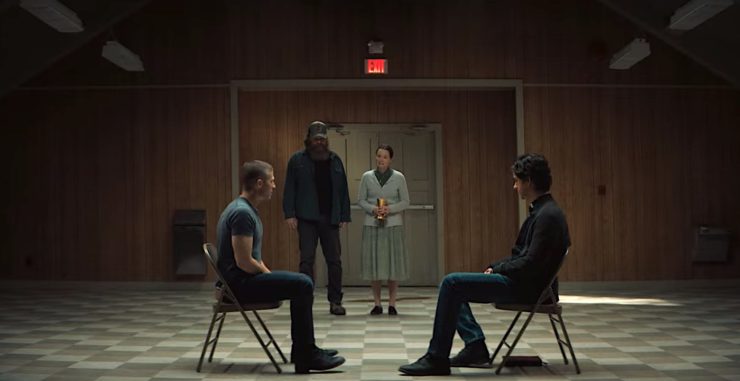
The priest is not a comfort. In The Exorcist films and TV show, the priests are authority figures, complicated ones, yes, but they all have a moral core that they ultimately stick to. In The Omen and Rosemary’s Baby, listening to priests sooner might have fixed some stuff. In Evil, whatever sexy CBS drama seminarian David Acosta is going through, he’s always going to crinkle his eyes with their impossible warmth and do his best to help people. Now, Father Paul Hill/Monsignor John is compromised from the moment we meet him. He is not a figure of comfort. He’s a real person with problems. He means well. He believes he’s serving God, and wants the best for his community. He’s also in a pact with a vampire who he believes is an angel. He is himself a vampire and subject to terrible cravings, and feels no remorse for eating people. Maybe worst of all he believes, truly, that this pact is a miracle, that vampirism is the eternal life he’s been promised, and that he needs to turn his parish into an immortal army for God and spread this immortality to the Chosen. He doesn’t see his own lack of remorse as a warning sign.
Which again, to be clear: this show is not anti-religion. The religious characters are treated with as much respect as the non-believers (except Bev, who’s just a jerk) and, honestly, John Pruitt’s equation of life as a murderous bloodsucking revenant with the type of immortality that’s being talked about in Christianity is actually a perversion of Christianity. He’s the one desecrating Communion, not the screenwriters. The “miracles” he performs are based in a pact with a creature that seems much more like a demon than anything angelic. I like the character a lot, but drinking blood from the veins of an obvious monster and calling that eternal life? That’s just shitty theology.
And about that.
There is a scene in this show where I clapped my hands over my mouth and laughed so hard—it was about 1am by that point and I didn’t want to disturb the neighbors. Because this one scene does so much: John Pruitt is saying the rosary in a futile attempt to stave off his terrible cravings. Looking down he sees that he’s cut his palms with the edges of the crucifix. He contemplates this for a moment, then gouges his palm and sucks his own blood out.
This may be the single greatest religious horror scene in history.
First, he’s saying the rosary specifically, perhaps the most incantatory of the popular prayers—you’re supposed to put yourself into a somewhat transcendent state when you say it, and the sight of someone praying so hard they’ve cut themselves with their rosary beads is the most Catholic shit ever. But wait! Using the crucifix to create an almost vaginal slit in his palm is both an incredible callback to Regan’s demonic rape scene in The Exorcist, and it creates vampiric stigmata? John then drinks of his own blood which has been called forth by a crucifix?
Are you fucking kidding me, Mike Flanagan? You beautiful fucking monster?
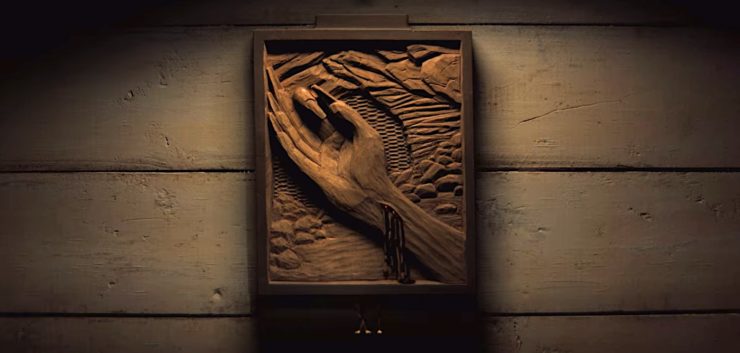
(And of course at other points, when either the “angel” or John himself slices a wrist open to allow a person to drink, they’re creating a more historically accurate version of stigmata, as generally nails were driven through peoples’ wrists during crucifixion, not their palms.)
There’s a beautiful detail in the way Riley prays. He and John say the Serenity together… kinda. Riley only chimes in on the word “serenity,” staying silent for the “God grant me” part. Speaking as a person who is lucky enough to have a lot of friends across a wide spectrum of interactions with faith, it was such a nice detail to watch him duck around the hypocrisy of saying things you don’t believe, while also honoring the rituals themselves. The show gives us a gorgeous variation on this when he’s trying to be supportive of Erin Green after her miscarriage—for her he’ll stand up and say some of the words, but only because he knows she believes them. He doesn’t want her to be alone.
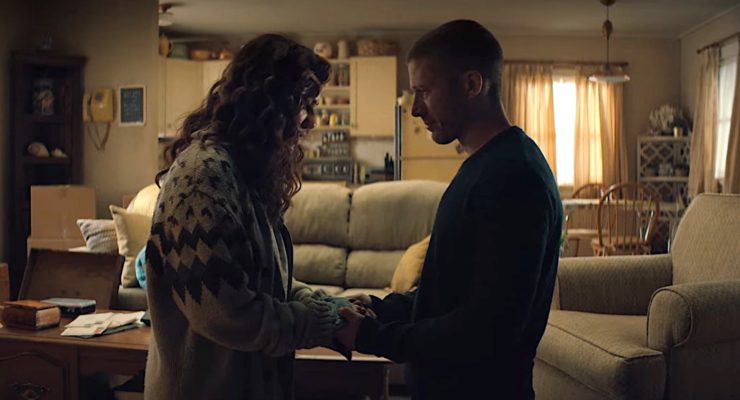
And just, the idea that there could be two hours of TV that revolve around someone hanging back during Communion? The respect and understanding of that, understanding that ritual’s importance, the fact that the congregation would ask about it, the way it worries Riley’s mom, the way he gives in to his mom and receives ashes at the beginning of Lent because that doesn’t quite cross his line. The way that that moment turns up as a callback thirty-nine days later in his note to John! Gorgeous.
The show is called Midnight Mass, takes place almost entirely during Lent, and then culminates in a candlelight Midnight Easter Service! This bugged the crap out of me! In a good way. In my experience at least, midnight mass is purely a Christmas Eve thing, and Easter is all about sunrises and early mornings. Seeing the whole community gather for this vampiric Easter service in the dark made my skin crawl and added a whole new layer to the horror for me. And yeah, this one might just be personal (I’m pretty sure there are non-vampiric midnight Easter services) but it felt off-kilter enough that when Flanagan finally fully reveals the angel/demon/vampire creature—in white and gold vestments!—that I shrieked with happiness.
Into a pillow, ’cause again, neighbors.
But even then! Even faced with this creature, there are still plenty of people, like our dear Beverly Keane, who will buy into anything John Pruitt’s telling them for a crack at immortality. And again, it’s beautiful to see Flanagan slice through tissue-thin divide between “religion,” “cult,” and “fucking Jonestown” as we watch the citizens of Crockett transform into flesh-eating demons for a while, before at least some of them come to their senses. It’s going to be many months, I think, before I forget the image of Howie Hobbes sobbing that he killed his wife, or Ooker realizing that he ate his mom. And then we watch as Bev tries to hide from the sunrise, or, I don’t know, the wrath of the Lord or whatever, and we watch Sheriff Hassan and his son praying on the cliffside, facing Mecca together, and we watch a whole crowd of vampires sing “Nearer My God, To Thee” as the sunlight torches them.
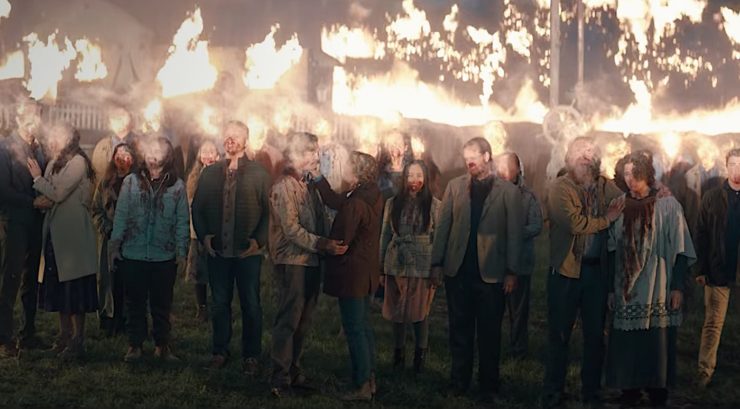
See, the thing with Christianity is that it’s super bloody. The point of all the iconography is to see broken, bleeding bodies everywhere you turn. It’s a constant memento-ing of mori. I think it’s fair to say that Catholicism is particularly dedicated to this. While Orthodox churches love ikons of Mary and various Saints and Christ Pantocrator—the triumphant risen Jesus come back to judge the living and the dead—and Protestant churches love metaphors and triumphant worship songs and Jesus fish, Catholicism stuck with the crucifix, as detailed as possible, blood and gore everywhere. It stuck with the idea that Transubstantiation is literal, and real. (If it’s a symbol to hell with it, as Flannery O’Connor said.)
But see, the focus on blood probably led to charges of cannibalism and baby-eating. (I always slap a probably on this stuff, because it’s so hard to tease out real historical fact from mythologizing.) The focus on blood definitely led to Catholicism being seen as alien and weird in the U.S., where Protestantism reigned supreme for a while. And that focus on blood is the crux (sorry) of Midnight Mass. Because who’s to say what that monster is? Is it a demon? A vampire? Is it, actually, an angel? (Or, as author and critic Tobias Carroll emailed me after he finished the show: “what if the same beings gave rise to stories of both angels and vampires?”) Monsignor John Pruitt reminds us that the first thing angels say to people is “be not afraid.” They are supposed to be terrifying. So maybe this creature’s species is the root of all those stories—of Dracula and Nephilim and Seraphim and Pazuzu. Maybe it does think it’s helping us?
…or maybe it’s just hungry.
(For all the Stephen King books we see on the shelves, I don’t think anyone says the word vampire? Did I miss it? Let me know if I missed it.)
But yeah, so, washed in the blood, etc. Crockett Island is certainly washed in blood by the end of episode seven. But again, the heart here is that Pruitt has sidestepped the natural order. His own fear of death is what allowed him to collapse the monstrous and the miraculous. It’s the same as End Times enthusiasts who think that encouraging certain political actions will force the Apocalypse. Why, it’s almost like casting yourself down from the pinnacle of a temple, or something like that.
There’s this scene in Passion of the Christ that I think about a lot. It’s actually the last scene, I think, so spoilers I guess, but you’ve had two thousand years to read this story, come on. After the rock is rolled away and a shaft of daylight is falling across the entrance to Jesus’ tomb, the music swells into a booming, militant crescendo, and we see Jesus’s foot stomp onto the step as he comes out into the light. This shot uhhh, upsets me. (Especially watching it in 2004, when this country was gripped in a particularly evangelical fervor that has come roaring back a couple times since.) Because I know the iconography that’s driving that shot—it’s the idea that the One Truth is about to march out across the land and crush all its enemies.
One Truths make me jittery. There are so many of them, and they cause so much destruction when they inevitably fight each other. (There are personal reasons, too, of course, there always are. But I’m keeping those in my head. Or, like, soul. Whatever.)
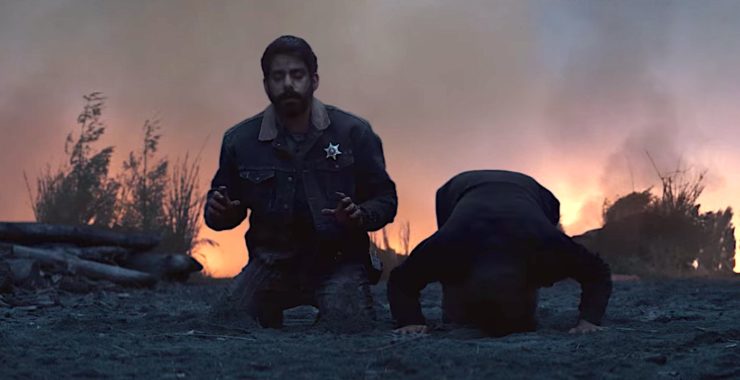
One of the truths of Midnight Mass is that it’s very friendly to lots of truths. One of its truths is that it grounds a lot of its horror, maybe its scariest horror, in people’s willingness to follow One Truth at any cost. I am so glad that after these last two-ish years of horror, illness, murder, bigotry—all the ugly truths that have only been made clearer—that one of our best genre stylists chose to make a series about how dangerous it is for a society to embrace One Truth above all others. He gave us a group of desperate heroes who were willing to sacrifice not just their lives, but a form of immortality to prevent a plague from spreading over the earth. And in the end, the show makes room for everybody’s Truth.
Leah Schnelbach would like everyone to acknowledge that they got through this whole post without any Rahul Kohli thirst. Come praise them on Twitter!










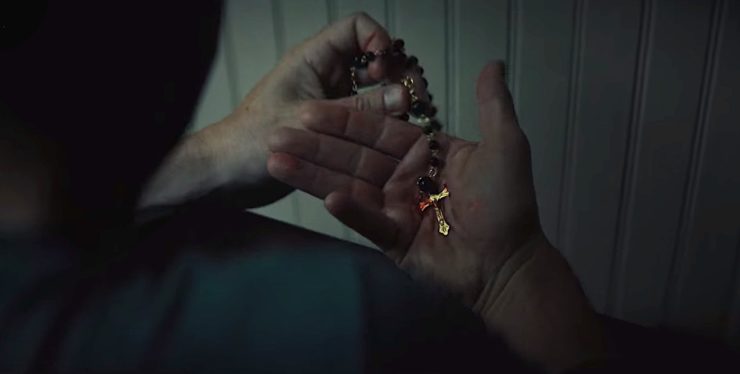
I’m a massive Mike Flanagan fan and Midnight Mass was incredible….it might even be his masterpiece or at least tied with Hill House.
I wondered if the vampire was some sort of creature, or one member of a race of creatures, that had been worshiped by ancient cultures that mistook it for a divine being, which then led to stories and scripture about angels and then later vampire legends. It seemed very comfortable with being worshiped.
Thank you for this excellent essay! You had so many great insights about the show and its finer points involving Catholic ritual and imagery. I too am a fan of religious horror, but I am a secular agnostic and unfamiliar with the details of Catholicism. For example, I initially missed the irony of having the Easter service at midnight and the significance of the rosary scene, and your explanation of those scenes increased my understanding of the symbolism behind them.
Really enjoyed reading this essay!
Fantastic and well-informed essay. Chiming in to point out two twisty side-passages down which to follow some of the points mentioned here:
– You quote King’s Stan talking about the cosmic horror of things that defy reason, including singing roses. King’s riffing on Arthur Machen’s classic short story ‘The White People.’ Skim the prologue for an extended take on Stan’s point, but fans of ‘Pan’s Labyrinth’ will appreciate the rest of the story.
– Possibly an edge case of ‘Easter Midnight Mass’ and one which isn’t widely celebrated anymore, but Tenebrae is a post-midnight, pre-dawn candlelight service in the nights leading up to Easter, in which a candle is put out for each reading, ending with the church in darkness. I can only imagine what a horror writer would do with an atmospheric set-up like that!
Long-ago altar boy here: Easter Midnight Mass absolutely is and has been a feature of Catholicism. (“Nearer My God to Thee” was never a Catholic hymn, although I realize the lines have blurred since my youth.)
re: was the word Vampire mentioned in the series? There is a interview with Flanagan about the series on youtube. Where he explained the V word was one of the forbidden words on the set. He didnt want that luggage wich comes with the vampire mythology, and somehow cheapen the things happening in the series.
Midnight Easter Vigil is absolutely a thing here in Italy, though the Roman Rite would start with the church in absolute darkness, and the candles would only be lit after the Service of Light. I understand why they made it differently on the show though, since a candle-lit church and procession is a much better visual on TV than, well, absolute darkness.
The lack of mentions of vampires annoyed me though. I see Flanagan’s point, and I usually accept that some stories won’t work if all the characters are genre-savvy, but in a show that is explicitly set in our world, in 2021, with characters who have read King and seen the X-Files, it really strained my disbelief that not a single person would acknowledge the similarity even just to lampshade it.
Easter Vigil yes, but it wouldn’t be a Mass. At least in the US no Mass is allowed until Easter morning. Vigil would normally be around 8 or 9 PM on Holy Saturday. Does the Midnight Vigil in Italy actually include a Mass?
I watched with captions on and the captions referred to the creature as an angel throughout.
Thank you for this text, it was excellent! And I think it also provided me with some context about US Catholicism. I’m from Brazil and this Catholicism seems so alien – it looks A LOT like some protestant churches here, in all the aspects, and I was really bugged because it’s not nearly as bLOODY or crazy as the stuff I grew up with. When I was a kid, there were miracles of Virgin Mary statues crying blood on Sunday television (in all places of Latin America), we have huge processions to santcuaries. During Easter, in the region where I live, there’s something called “Procissão do Fogaréu”, that is SO FREAKING SCARY (you can take a look at wikipedia). We had whole rebellions against Portugal and the Brazilian Empire that were led by these Half-Messianic figures, almost saints, people that are venerated until today. There are some stuff that’s recognizable in the series, but for the most part, it was something so strange to me.
But the thing about catholicism that I think the series captures well is that it adapts. It takes the shape that fits the most in a community, in the culture that it wants to take over, and these differences that were so strange to me are born of that – of the fact that just like the ‘angel’, catholicism took a form that made it’s survival and spread possible.
Despite this first cultural shock, I really loved Midnight Mass for it’s themes and the way it handles the characters, all the faiths. It’s an incredible addition to religious horror.
This is honestly a really cool and good reading of this show, I think. I watched the entire thing in a fugue over the course of two days. While I’m not really a huge fan of it (I honestly prefer Hill House over this one), I do love the themes and the messages in this show, as well as the delicate play between faith and faithlessness, and religion and atheism, and all of that. While I see this show not necessarily centered in Catholicism, per se, rather than conservative American Christianity (after all, with the exception of the chasuble, altar boys, and confessional, this could easily have taken place in my childhood Baptist church), it’s still certainly very grounded in some form of religion and how it can be just as horrifying as anything without religion.
That being said, there is one thing in this essay that I’d take issue with:
I’d argue that it’s not Monsignor Pruitt that couldn’t accept that his life was at an end, but instead the wider community. Even Riley, who hadn’t been back in years, knew that Monsignor Pruitt was too old to go on a pilgrimage to the Holy Land, and Pruitt himself said that he was in the grips of dementia and should never have been allowed to go on his own. If his community accepted that he was at the end of his life, that he needed care and love at home to nurse him through his dementia, then this whole mess wouldn’t have started, but an old man with dementia can’t be held accountable for not accepting his life is at an end. And that’s not acknowledging that he didn’t exactly allow the angel/vampire to do anything for him. The angel attacked him and turned him, and Pruitt did nothing, and then rationalized it the best way that he could.
Simply superb! Bravo!
I could go back and forth with much of what you’ve said, and I enjoyed your essay a great deal. The series was outstanding. Just a couple of things to add, really.
Erin’s cutting of the angel’s wings was a gorgeous call-back to her telling Riley about the story of the doves and her mother, and the clipping of wings.
Riley’s atheism was such a strong and healthy viewpoint throughout the tale that I felt like his interaction with the ghost of the girl he killed was almost a red herring. His misery at being forced to endure years of AA meetings when he’d rather have been at RR meetings was a fucking breath of fresh air – especially since AA is as much a cult as is Catholicism (except it does even less good).
Ultimately, though, I didn’t come away thinking that MM was a horror story, a morality tale, an evisceration of sheeple mentality, or some of the finest acting I’ve seen this year. I thought it was about love, and what people will do for it.
There was just a lot of blood spilled or consumed before that kiss on the little bridge happened.
Easter Vigil was always followed by Midnight Mass in my Maryland childhood. I promise you, I was there every year.
Leah, I just read your other beautiful piece, and came here thinking that this one couldn’t be better. I’m happy to have been proven wrong.
Here I was hoping for a good version of F. Paul Wilson’s story “Midnight Mass.” But this seems to be unrelated.
So much to like about the series, and I’ve watched a lot of Flanagan’s stuff and enjoy it very much for the most part, but I honestly can’t abide the overlong soliloquies. I know it’s kind of a brand for him at this point but as a trained editor, I cringe whenever one of those characters sits down and starts looking pensively at someone else, because I know there’s 10 minutes of repetitive imagery coming